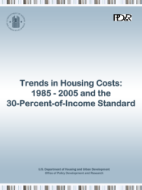
An official website of the United States government
Here’s how you know
Official websites use .gov
A .gov website belongs to an official government organization in the United States.
Secure .gov websites use HTTPS
A lock (
) or https:// means you’ve safely connected to the .gov website. Share sensitive information only on official, secure websites.
-
//
- Census.gov /
- Our Surveys & Programs /
- American Housing Survey (AHS) /
- Research /
- Technical Survey Research /
- Trends in Housing Costs: 1985-2005 and the 30-Percent-of-Income Std.
Trends in Housing Costs: 1985-2005 and the 30-Percent-of-Income Standard
Trends in Housing Costs: 1985-2005 and the 30-Percent-of-Income Standard
Shelter, along with food and other basic consumer items, is considered a basic human need. For this reason, public policy has focused on the ability of families both to acquire safe and sanitary housing in decent neighborhoods and to have sufficient income left over to purchase other essential goods and services. Over time, policy analysts have adopted the “30 percent” standard to assess the affordability of housing. The standard is centered on the belief is that households who have to pay more than 30 percent of their income for housing may be forced to forego other important needs. This study draws on American Housing Survey data to examine two issues related to housing costs: What factors account for the changes in housing costs relative to income from 1985 to 2005? Is the 30-percent standard still appropriate for assessing housing affordability? Part 1 of this report examines trends in the components of housing costs, including data and methodology issues and trends in housing costs for owners with mortgages, owners without mortgages, and renters. Part 2 looks at the adequacy of the 30-percent-of-income standard and looks for an alternative way to evaluate the adequacy of the standard.
Share
Some content on this site is available in several different electronic formats. Some of the files may require a plug-in or additional software to view.
 Yes
Yes
 No
NoComments or suggestions?


Top


